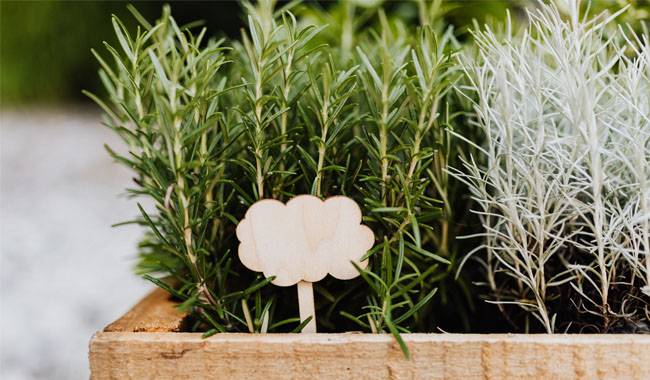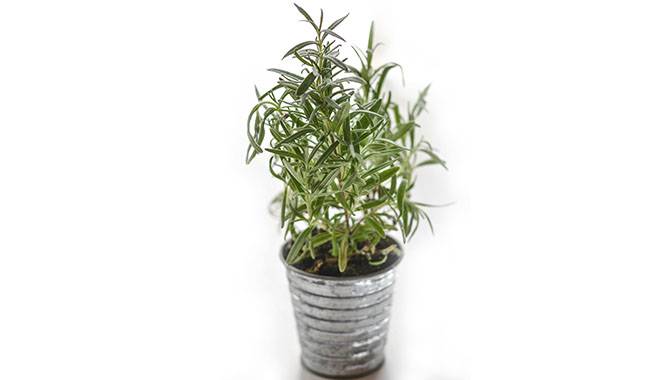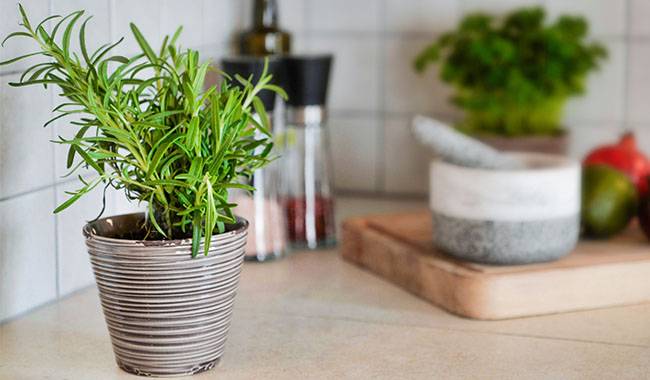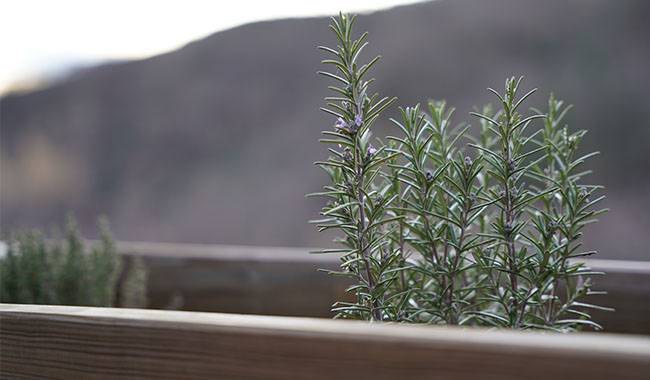
The stunning rosemary can be grown outdoors in the garden, or on a windowsill or balcony. The easiest way to grow rosemary is through seedlings.
Knowing the scheme and rules of how to plant rosemary, you can easily grow beautiful and healthy rosemary plants that will delight you with their decorative look and delicious greenery.
INFORMATION ABOUT ROSEMARY
Rosemary (Rosmarinus) is an evergreen perennial shrub of the Labiatae family with narrow, fragrant leaves, green above and white below, resembling pine needles, with small blue-purple flowers.
Rosemary is a very valuable plant. It is used in medicine, cooking, and beauty. The essential oil contained in rosemary leaves has antiseptic and wound healing properties.
Rosemary has the ability to remove toxic substances from the liver. It is also used as a diuretic herb to normalize the cardiovascular system. Use rosemary in tea or herbal remedies to treat headaches and as a gargle.
It is hard to imagine Mediterranean cuisine without rosemary in the dishes. It has a nice spicy flavor and a pleasant bitterness. Fresh herbs can be added to soups and hot meat dishes. The dried shoots and leaves can be added to a variety of spice compositions.
ROSEMARY IN LANDSCAPING
Like lavender, rosemary can be planted in groups or mixed with other plants in a mixed bed.
In southern countries, rosemary is often used as a hedge. Southern fences and walls are also good to put rosemary on.
There are some varieties of rosemary that have stem buds. They are good for planting retaining walls and steps. They are used to beautify and reinforce slopes.
When creating a Mediterranean-style garden, you can’t do without roses, lavender, and rosemary.
But if you can always choose from a variety of rose varieties that are hardy enough for almost any climate zone, rosemary can be planted in containers.
Classic garden vases can work well with the design and accentuate the style.
ROSEMARY FACTS
“Sea Fresh” or rosemary is a shrub of the blue flower or clover family, native to the Mediterranean coast. The shrub has been used since ancient times as a spice or medicinal preparation. In some countries, it is a sacred shrub.
Rosemary is a perennial evergreen shrub with dense branches and olive or gray leaves that resemble the needles of spruce.
The shrub has a dense crown and small, white or light blue flowers. If you rub the twigs with your hands, you can feel the bright, characteristic fragrance. Outdoors can grow to a height of about two meters with good care and watering.
It grows wild on the Mediterranean coast. People in Western Europe and Morocco use rosemary in particular.
There, the shrub grows as a spice in meat, fish, poultry, mushrooms, soups, salads, and even baked goods. Eucalyptus, camphor, lemon, and pine trees all smell much like rosemary together.
Rosemary is a well-known source of medicinal uses. The plant is used to treat respiratory and digestive disorders, as an antiseptic for small wounds and fungal diseases.
Wattle helps to treat insomnia, raise blood pressure, stimulate the brain and activate memory. The essential oil is used as an ingredient in many shampoos as well as rubs.
People suffering from epilepsy and high blood pressure, as well as pregnant women, should use rosemary with caution. In apartments, it is worth growing the shrub as a disinfectant, it neutralizes unpleasant odors and kills bacteria and viruses.
Bags filled with rosemary are often used to control moths.
PROPERTIES OF ROSEMARY: BENEFITS AND DRAWBACKS.
The therapeutic properties of rosemary
Since ancient times, rosemary has been a symbol of prosperity, abundance, and longevity. That’s why newlyweds make their wedding gifts in the form of rosemary.
It is also a medicinal plant with antioxidant, anti-inflammatory, choleretic, tonic, and wound-healing properties.
This plant is used in the treatment of rheumatism, low blood pressure, fatigue, sciatica, sexual weakness, and it is also used in the treatment of menopause.
This shrub is also used in the treatment of some heart diseases, colds, and flu, and it also acts as an invigorator of blood stasis. It is also used as an effective remedy against cellulite and obesity.
Rosemary oil is highly valued. It is used to treat boils, acne, infected wounds, and eczema. It is extracted by steam from the leaves, shoots, and flowers. Rosemary is also used as a seasoning in cooking, added to meat and fish dishes, sauces, salads, and teas.
Contraindications of rosemary
Rosemary and products made from it (infusions, tinctures, decoctions, and oils) should never be used by pregnant women. It is also highly discouraged if you are prone to seizures, epilepsy, high blood pressure, children under 9 years of age, and skin allergies.
GROWING CONDITIONS
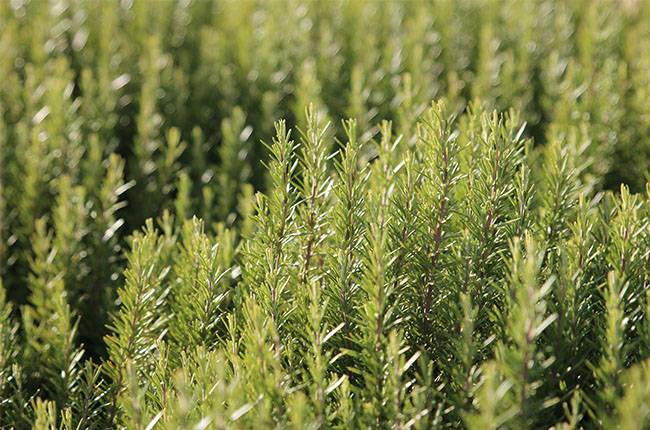
Rosemary is a heat-loving, light-loving, and frost-tolerant plant. It is best grown outdoors when there is no threat of frost.
Mature plants can withstand frost, but not below -4°C (24.8°F). Rosemary needs a lot of sun in the summer and cools to 10-13°C (50-55.4°F) in the winter, otherwise, the shrub will not bloom.
In winter, the light dose should be 6-8 hours, so often rosemary needs increased light. Through lack of light, the upper leaves of the shrub will become less dense and elongated.
The plant prefers loose, permeable, calcareous soil. It does not like soils that are too moist or acidic. Although this shrub is a fast grower, it is not afraid of disease. It is also not afraid of pests.
To grow rosemary in your apartment, you should get a terracotta or clay pot. You also need to ensure good drainage, and you can use pebbles or expanded clay. You should turn the plant regularly to form an even canopy.
It is important to ventilate the room regularly. In summer, you can put a potted plant on the balcony or plant it in the ground.
It is important to note that rosemary does not like sharp changes in temperature. The shrub gets along well with basil, thyme, laurel, and parsley, so they can be planted in the same container.
Rosemary grown in the open ground is a strong plant. It is not afraid of pests. Indoor shrubs are weaker, so they can be affected by false powdery mildew, powdery mildew, and aphids. To get rid of insects, it is enough to bury the rosemary shrub in a mile of water several times (be sure to cover it with soil).
WHEN TO SOW SEEDS IN THE SEEDLING STAGE
Rosemary can be propagated by seeds, cuttings, divisions of shrubs, and grafting. In areas with cold winters, it is recommended to sow rosemary by seedlings. sowing in the last days of February or the first days of March.
Characteristics of sowing seeds
Before sowing, the seeds should be soaked in water for several hours. When the seeds swell, sow them in moist sand or vermiculite, deep into the substrate only 0.3-0.4cm (0.11-0.15inch), the top of the container must be covered with plastic film.
If you want the seedlings to emerge as soon as possible, keep placing the seeds constantly in a warm environment at 25-30°C (77-86°F).
Don’t forget to systematically remove the lid from the sprayer and moisten the substrate so that it is always a little moist.
If you did everything correctly, the first seedlings should appear in 6-8 weeks. Immediately afterward, remove the cover and move the seedlings to a well-lit area.
Remember to regularly water the substrate in the container with warm, well-drained water. When the seedlings are 70-80 mm high, they can be planted in the open ground.
GROWING ROSEMARY AT HOME
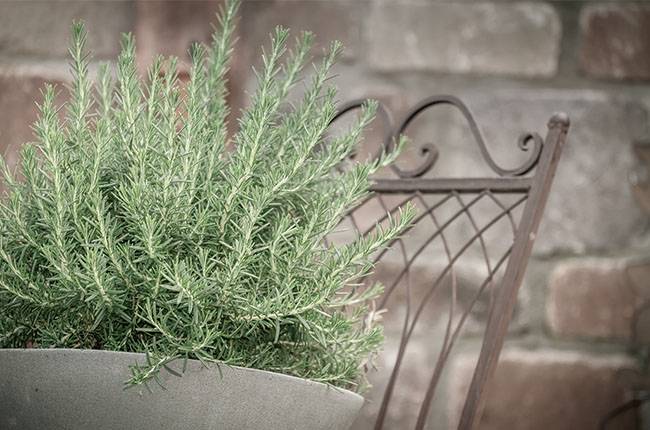
Planting
First plant rosemary seedlings from seeds, how to do this is described in detail above.
Once the height of the seedlings will equal 70-80 mm, they are poured into individual pots (preferably taking clay soil), which should reach 9-11 cm (3.54-4.33inch) in cross-section and must have drainage holes in the bottom.
The container should be filled with a substrate with good permeability and air permeability, for which a universal soil mixture is created combined with vermiculite or sand.
This can be made from a mixture of humus, sand, turf, and deciduous soil (2:1:2:2). A small hole should be made in the moist soil mixture to a depth equal to the height of the seedling’s roots.
Carefully remove the plant from the container, take it out together with the soil ball and plant it in the pre-prepared pot. Gently tamp down the substrate around the plant.
Light and temperature
It is recommended to place the planted shrubs on a south-facing window. To make the crown of rosemary beautiful and not skewed, periodically place the container with the plant 180 degrees around its axis for 7 days.
In spring and summer, if possible, outdoors (on the terrace, garden or balcony). In autumn, once the temperature drops to -1°C (30.2°F), move the plants indoors.
Ventilating a room with rosemary is not advisable, as cold air from outside the window may harm it.
However, if the air is not circulated indoors, then mildew may appear on the shrub. To avoid this, it is necessary to turn on the fan in the room for 3-4 hours a day.
In winter, the air temperature in the room should be lower than 16°C (60.8°F) and the humidity of the bush should be lower at this time of the year.
Pests
Aphids and spiders will settle on the plant when growing at room temperature. If pests are found on the bush, treat it with an acaricide or insecticide solution. Remember, it may take several treatments to get rid of the pests completely.
Watering
Make sure that the potting soil is kept slightly moist (not soggy). You can tell when a shrub needs water by looking at its lower leaves: they will turn yellow. If there is too much water in the potting soil, the leaves will fall off.
Moisten the substrate in the pot with a long, narrow spout, as the water should not get on the surface of the leaves or it will cause mildew. Let it sit for at least a day before watering, and the water temperature should be close to room temperature.
Fertilization
During the growing season from March to September, plants need a mineral fertilizer, which must include calcium. Fertilize regularly twice a month. During the winter months, you will not fertilize them at all, or only about every 4 to 6 weeks.
GROWING ROSEMARY OUTDOORS
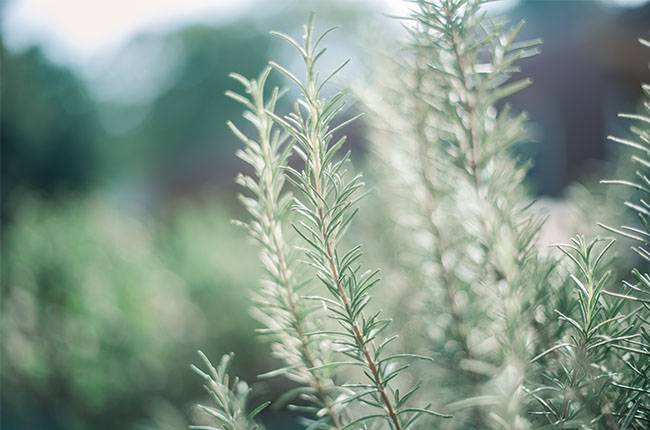
You can grow rosemary outdoors. In a well-lit area and protected from gusts of wind. The soil needs to be light, loose, permeable, and breathable, with a calcareous consistency.
Seedlings should be planted in the open ground starting in mid to late May after warm weather has established when the plants should reach 70 to 80 mm in height.
If you plan to plant large shrubs, then keep a distance of half a meter when planting seedlings. If you do not intend to do so, then it is sufficient to maintain a distance of 10 cm (3.93inch) between seedlings. Planted shrubs should be watered.
Characteristics of care
Growing rosemary in the garden is not as difficult as it seems. It is cared for in almost the same way as other garden crops, i.e. it should be watered, moistened, weeded, and pruned systematically, and do not forget to loosen the top layer of soil in time.
Seven days after planting, the top of the stem needs to be pruned to make it grow more lush and showy. Remember that after such a plant is planted in the open ground, the first flowering time cannot be earlier than the following year.
Pruning
Straight rosemary bushes, starting from 2 years old, are cut at the height of 3-4 internodes of the previous year’s growth, which is done in April. Prostrate rosemary does not need to be cut.
To rejuvenate the bush, it should be pruned every 7 years, cutting all stems to the soil level.
Spring pruning is also carried out in the same way. The plant can be shaped into cubes, balls, or miniature trees (e.g. in the form of cypress trees). Rosemary broom-shaped bonsai are very popular with gardeners.
Overwintering
This shrub is heat-loving, so in mid-latitudes, it can die in winter.
To save the plant until spring, dig it up and plant it in a container, then transfer it to a room with plenty of light and shade no higher than 16°C (60.8°F).
If digging it up is not possible, cut it on the ground and cover it with a layer of dried leaves or sawdust, surrounded by a tent made of spruce branches.
Watering
Rosemary is a drought-tolerant plant, but it still needs a lot of water. If it doesn’t get enough water, then the lower leaves will start to turn yellow.
And because the liquid often stagnates in the ground, part of the shrub’s root system will die and what can also be observed is that its leaves fall off.
Watering should be moderate. Pour the water carefully under the roots, because if it gets drops of water on the leaves, this can start to develop mold.
Fertilizer
In the spring, it is recommended to apply nitrogen fertilizer in the soil of the site, which will give a good start to the growth of rosemary.
Then during the growing season, the soil is systematically fertilized with a compound fertilizer every 30 days. In the fall, fertilize with a chemical fertilizer, which does not contain nitrogen, but has a lot of phosphorus.
WHAT SHOULD I PLANT IN THE PLOT AFTER ROSEMARY?
This plant is perennial, but if you decide to remove it from the plot, then you should dig up the bushes and clean the soil of the plant residue.
Dig the soil back into the ground and add compost or humus. Onions, carrots, and garlic will grow well in such an area.
Propagation methods
The above article details how to grow rosemary from seed. However, this is not the only way to propagate this shrub. Therefore, it can also be propagated by transplants, cuttings, and divisions.
Grafting
Prepare cuttings in September-October, using annual stems for this purpose. The cuttings should be 8-10cm (3.14-3.93inch) long with 3-4 internodes.
Cut off all the leaves at the bottom and give the bottom cuttings to prepare them for root stimulation.
Plant the cuttings in containers filled with a loose and light substrate that is permeable and airy and sterilized beforehand (e.g., a mixture of vermiculite and peat). The cuttings should be taken to a warm place, out of direct sunlight.
Make sure the potting soil in the container is kept slightly moist, and the cuttings themselves should be moistened with daily sprays of water from a sprayer.
After the cuttings have grown new leaves, transplant them into their own pots, which are 70 to 90 mm in diameter. Seven days after transplanting, prune the tips of the cuttings to make them grow more lush and showy.
Tap
To propagate rosemary by grafting, choose shoots that grow very close to the ground. Bend the shoots to the ground, then bind them well and bury them in the soil so that the top of the stem is above the ground.
The stems must be watered frequently so that the soil around them is always a little moist. After the stems start to grow, cut off the fallen branches from the mother plant and plant them in pots or in open soil.
Branching
When growing rosemary under home conditions, branching is the most common method of propagation. Once the shrub is removed from the container, its roots are divided into several parts.
Note that each division should have stems and roots. Sprinkle the cutting point with carbon powder and plant the divisions in individual pots.
Diseases and pests
When grown outdoors, rosemary is highly resistant to disease and pests. However, homegrown shrubs are sometimes affected by false powdery mildew in winter, and powdery mildew and aphids can settle on them.
To get rid of the pests, wash the shrubs gently with soap and then under a shower of warm water.
And the surface of the substrate in the container must be covered with a film so that the soapy water does not enter it.
To prevent the appearance of false powdery mildew, do not allow the humidity in the room and the humidity of the soil mix in the pots to increase excessively. It is also recommended by experts to use a fan to create indoor air circulation in winter.
HARVESTING ROSEMARY
What is harvested and what to use as a seasoning? Naturally, herbs. It is best to do it on a sunny day. When rosemary blooms, the young shoots covering the dense leaves and flowers are cut off, dried in the shade, and crushed. This makes a spice for meat.




